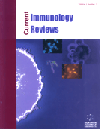-
s Innate Immunity and the Role of Epithelial Barrier During Aspergillus fumigatus Infection
- Source: Current Immunology Reviews (Discontinued), Volume 8, Issue 3, Aug 2012, p. 254 - 261
-
- 01 Aug 2012
- Previous Article
- Table of Contents
- Next Article
Abstract
Fungi are the most important eukaryotic infective agents in Europe which largely overpass parasite infections. Total number of people dying of fungal infection is increasing and this trend is likely to continue due to the increase in immunosuppressive treatments. The opportunistic pathogen Aspergillus fumigatus (Af) is a saprophytic filamentous fungus that can cause invasive pulmonary diseases in immuno-compromised hosts. In veterinary medicine aspergillosis is also a recurrent problem since it infects various species, birds are particularly susceptible. It propagates through airborne conidia (spores), which are inhaled into the small airways where they may germinate and initiate an infection. The host epithelium has permanent contact with the environment and a multitude of diverse microorganisms, resulting in a network of the host’s defense mechanisms. Pathogens use various strategies to invade epithelial barriers, to exploit eukaryotic host function to their own benefit and disseminate throughout the host using the epithelium as a reservoir. The current revue will discuss the ways how epithelial and innate immunity cells can contlol Af infection. We will focus on Af strategies for the host’s invasion, antifungal innate immune response and antimicrobial activities of the respiratory epithelial cells.


